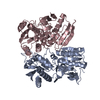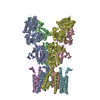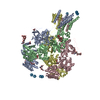[English] 日本語
 Yorodumi
Yorodumi- EMDB-3356: Activation of NMDA receptors and the mechanism of inhibition by i... -
+ Open data
Open data
- Basic information
Basic information
| Entry | Database: EMDB / ID: EMD-3356 | |||||||||
|---|---|---|---|---|---|---|---|---|---|---|
| Title | Activation of NMDA receptors and the mechanism of inhibition by ifenprodil - Class Y | |||||||||
 Map data Map data | Class Y, unsharpened, unmasked map | |||||||||
 Sample Sample |
| |||||||||
 Keywords Keywords |  NMDA receptor / NMDA receptor /  glutamate receptor / GluN1 / GluN2B / glutamate receptor / GluN1 / GluN2B /  ion channel ion channel | |||||||||
| Function / homology |  Function and homology information Function and homology informationneurotransmitter receptor activity involved in regulation of postsynaptic membrane potential / cellular response to curcumin / cellular response to corticosterone stimulus / cellular response to magnesium starvation / regulation of postsynaptic cytosolic calcium ion concentration / NMDA selective glutamate receptor signaling pathway / sensory organ development /  sensitization / pons maturation / sensitization / pons maturation /  regulation of cell communication ...neurotransmitter receptor activity involved in regulation of postsynaptic membrane potential / cellular response to curcumin / cellular response to corticosterone stimulus / cellular response to magnesium starvation / regulation of postsynaptic cytosolic calcium ion concentration / NMDA selective glutamate receptor signaling pathway / sensory organ development / regulation of cell communication ...neurotransmitter receptor activity involved in regulation of postsynaptic membrane potential / cellular response to curcumin / cellular response to corticosterone stimulus / cellular response to magnesium starvation / regulation of postsynaptic cytosolic calcium ion concentration / NMDA selective glutamate receptor signaling pathway / sensory organ development /  sensitization / pons maturation / sensitization / pons maturation /  regulation of cell communication / positive regulation of Schwann cell migration / EPHB-mediated forward signaling / Assembly and cell surface presentation of NMDA receptors / neurotransmitter receptor activity involved in regulation of postsynaptic cytosolic calcium ion concentration / olfactory learning / regulation of cell communication / positive regulation of Schwann cell migration / EPHB-mediated forward signaling / Assembly and cell surface presentation of NMDA receptors / neurotransmitter receptor activity involved in regulation of postsynaptic cytosolic calcium ion concentration / olfactory learning /  conditioned taste aversion / regulation of protein kinase A signaling / protein localization to postsynaptic membrane / conditioned taste aversion / regulation of protein kinase A signaling / protein localization to postsynaptic membrane /  apical dendrite / apical dendrite /  dendritic branch / regulation of respiratory gaseous exchange / propylene metabolic process / response to glycine / response to other organism / fear response / response to methylmercury / voltage-gated monoatomic cation channel activity / response to morphine / glutamate-gated calcium ion channel activity / positive regulation of cysteine-type endopeptidase activity / cellular response to dsRNA / regulation of monoatomic cation transmembrane transport / response to carbohydrate / dendritic branch / regulation of respiratory gaseous exchange / propylene metabolic process / response to glycine / response to other organism / fear response / response to methylmercury / voltage-gated monoatomic cation channel activity / response to morphine / glutamate-gated calcium ion channel activity / positive regulation of cysteine-type endopeptidase activity / cellular response to dsRNA / regulation of monoatomic cation transmembrane transport / response to carbohydrate /  interleukin-1 receptor binding / negative regulation of dendritic spine maintenance / cellular response to lipid / positive regulation of glutamate secretion / interleukin-1 receptor binding / negative regulation of dendritic spine maintenance / cellular response to lipid / positive regulation of glutamate secretion /  NMDA glutamate receptor activity / NMDA selective glutamate receptor complex / RAF/MAP kinase cascade / response to growth hormone / Synaptic adhesion-like molecules / parallel fiber to Purkinje cell synapse / calcium ion transmembrane import into cytosol / response to manganese ion / protein heterotetramerization / NMDA glutamate receptor activity / NMDA selective glutamate receptor complex / RAF/MAP kinase cascade / response to growth hormone / Synaptic adhesion-like molecules / parallel fiber to Purkinje cell synapse / calcium ion transmembrane import into cytosol / response to manganese ion / protein heterotetramerization /  glutamate binding / positive regulation of reactive oxygen species biosynthetic process / neuromuscular process / glutamate binding / positive regulation of reactive oxygen species biosynthetic process / neuromuscular process /  regulation of synapse assembly / regulation of synapse assembly /  glycine binding / glycine binding /  action potential / positive regulation of calcium ion transport into cytosol / regulation of neuronal synaptic plasticity / male mating behavior / regulation of dendrite morphogenesis / action potential / positive regulation of calcium ion transport into cytosol / regulation of neuronal synaptic plasticity / male mating behavior / regulation of dendrite morphogenesis /  regulation of axonogenesis / receptor clustering / regulation of axonogenesis / receptor clustering /  heterocyclic compound binding / suckling behavior / behavioral response to pain / heterocyclic compound binding / suckling behavior / behavioral response to pain /  startle response / response to amine / monoatomic cation transmembrane transport / startle response / response to amine / monoatomic cation transmembrane transport /  social behavior / ligand-gated monoatomic ion channel activity / social behavior / ligand-gated monoatomic ion channel activity /  small molecule binding / positive regulation of excitatory postsynaptic potential / small molecule binding / positive regulation of excitatory postsynaptic potential /  regulation of MAPK cascade / response to magnesium ion / regulation of MAPK cascade / response to magnesium ion /  associative learning / monoatomic cation transport / associative learning / monoatomic cation transport /  excitatory synapse / positive regulation of dendritic spine maintenance / extracellularly glutamate-gated ion channel activity / cellular response to organic cyclic compound / neuron development / Unblocking of NMDA receptors, glutamate binding and activation / excitatory synapse / positive regulation of dendritic spine maintenance / extracellularly glutamate-gated ion channel activity / cellular response to organic cyclic compound / neuron development / Unblocking of NMDA receptors, glutamate binding and activation /  long-term memory / regulation of postsynaptic membrane potential / long-term memory / regulation of postsynaptic membrane potential /  glutamate receptor binding / behavioral fear response / D2 dopamine receptor binding / glutamate receptor binding / behavioral fear response / D2 dopamine receptor binding /  phosphatase binding / multicellular organismal response to stress / calcium ion homeostasis / phosphatase binding / multicellular organismal response to stress / calcium ion homeostasis /  synaptic cleft / cellular response to manganese ion / synaptic cleft / cellular response to manganese ion /  prepulse inhibition / positive regulation of synaptic transmission / detection of mechanical stimulus involved in sensory perception of pain / response to mechanical stimulus / response to electrical stimulus / regulation of neuron apoptotic process / presynaptic active zone membrane / response to fungicide / cellular response to forskolin / glutamate-gated receptor activity / monoatomic cation channel activity / sensory perception of pain prepulse inhibition / positive regulation of synaptic transmission / detection of mechanical stimulus involved in sensory perception of pain / response to mechanical stimulus / response to electrical stimulus / regulation of neuron apoptotic process / presynaptic active zone membrane / response to fungicide / cellular response to forskolin / glutamate-gated receptor activity / monoatomic cation channel activity / sensory perception of painSimilarity search - Function | |||||||||
| Biological species |   Rattus norvegicus (Norway rat) Rattus norvegicus (Norway rat) | |||||||||
| Method |  single particle reconstruction / single particle reconstruction /  cryo EM / Resolution: 6.25 Å cryo EM / Resolution: 6.25 Å | |||||||||
 Authors Authors | Tajima N / Karakas E / Grant T / Simorowski N / Diaz-Avalos R / Grigorieff N / Furukawa H | |||||||||
 Citation Citation |  Journal: Nature / Year: 2016 Journal: Nature / Year: 2016Title: Activation of NMDA receptors and the mechanism of inhibition by ifenprodil. Authors: Nami Tajima / Erkan Karakas / Timothy Grant / Noriko Simorowski / Ruben Diaz-Avalos / Nikolaus Grigorieff / Hiro Furukawa /  Abstract: The physiology of N-methyl-d-aspartate (NMDA) receptors is fundamental to brain development and function. NMDA receptors are ionotropic glutamate receptors that function as heterotetramers composed ...The physiology of N-methyl-d-aspartate (NMDA) receptors is fundamental to brain development and function. NMDA receptors are ionotropic glutamate receptors that function as heterotetramers composed mainly of GluN1 and GluN2 subunits. Activation of NMDA receptors requires binding of neurotransmitter agonists to a ligand-binding domain (LBD) and structural rearrangement of an amino-terminal domain (ATD). Recent crystal structures of GluN1-GluN2B NMDA receptors bound to agonists and an allosteric inhibitor, ifenprodil, represent the allosterically inhibited state. However, how the ATD and LBD move to activate the NMDA receptor ion channel remains unclear. Here we applied X-ray crystallography, single-particle electron cryomicroscopy and electrophysiology to rat NMDA receptors to show that, in the absence of ifenprodil, the bi-lobed structure of GluN2 ATD adopts an open conformation accompanied by rearrangement of the GluN1-GluN2 ATD heterodimeric interface, altering subunit orientation in the ATD and LBD and forming an active receptor conformation that gates the ion channel. | |||||||||
| History |
|
- Structure visualization
Structure visualization
| Movie |
 Movie viewer Movie viewer |
|---|---|
| Structure viewer | EM map:  SurfView SurfView Molmil Molmil Jmol/JSmol Jmol/JSmol |
| Supplemental images |
- Downloads & links
Downloads & links
-EMDB archive
| Map data |  emd_3356.map.gz emd_3356.map.gz | 19.8 MB |  EMDB map data format EMDB map data format | |
|---|---|---|---|---|
| Header (meta data) |  emd-3356-v30.xml emd-3356-v30.xml emd-3356.xml emd-3356.xml | 11.8 KB 11.8 KB | Display Display |  EMDB header EMDB header |
| Images |  image_3356.png image_3356.png | 408.7 KB | ||
| Archive directory |  http://ftp.pdbj.org/pub/emdb/structures/EMD-3356 http://ftp.pdbj.org/pub/emdb/structures/EMD-3356 ftp://ftp.pdbj.org/pub/emdb/structures/EMD-3356 ftp://ftp.pdbj.org/pub/emdb/structures/EMD-3356 | HTTPS FTP |
-Related structure data
| Related structure data |  5fxkMC  3352C  3353C  3354C  3355C  5b3jC  5fxgC  5fxhC  5fxiC  5fxjC M: atomic model generated by this map C: citing same article ( |
|---|---|
| Similar structure data |
- Links
Links
| EMDB pages |  EMDB (EBI/PDBe) / EMDB (EBI/PDBe) /  EMDataResource EMDataResource |
|---|---|
| Related items in Molecule of the Month |
- Map
Map
| File |  Download / File: emd_3356.map.gz / Format: CCP4 / Size: 62.5 MB / Type: IMAGE STORED AS FLOATING POINT NUMBER (4 BYTES) Download / File: emd_3356.map.gz / Format: CCP4 / Size: 62.5 MB / Type: IMAGE STORED AS FLOATING POINT NUMBER (4 BYTES) | ||||||||||||||||||||||||||||||||||||||||||||||||||||||||||||
|---|---|---|---|---|---|---|---|---|---|---|---|---|---|---|---|---|---|---|---|---|---|---|---|---|---|---|---|---|---|---|---|---|---|---|---|---|---|---|---|---|---|---|---|---|---|---|---|---|---|---|---|---|---|---|---|---|---|---|---|---|---|
| Annotation | Class Y, unsharpened, unmasked map | ||||||||||||||||||||||||||||||||||||||||||||||||||||||||||||
| Voxel size | X=Y=Z: 1.31 Å | ||||||||||||||||||||||||||||||||||||||||||||||||||||||||||||
| Density |
| ||||||||||||||||||||||||||||||||||||||||||||||||||||||||||||
| Symmetry | Space group: 1 | ||||||||||||||||||||||||||||||||||||||||||||||||||||||||||||
| Details | EMDB XML:
CCP4 map header:
| ||||||||||||||||||||||||||||||||||||||||||||||||||||||||||||
-Supplemental data
- Sample components
Sample components
-Entire : NMDA Receptor
| Entire | Name: NMDA Receptor |
|---|---|
| Components |
|
-Supramolecule #1000: NMDA Receptor
| Supramolecule | Name: NMDA Receptor / type: sample / ID: 1000 Details: The sample was purified in the presence of agonists Glycine and L-glutamate. Oligomeric state: One heterotetramer of 2 GluN1 and 2 GluN2B subunits Number unique components: 2 |
|---|---|
| Molecular weight | Theoretical: 370 KDa |
-Macromolecule #1: N-methyl-D-aspartate receptor GluN1
| Macromolecule | Name: N-methyl-D-aspartate receptor GluN1 / type: protein_or_peptide / ID: 1 / Name.synonym: GluN1, NR1 / Number of copies: 2 / Oligomeric state: dimer / Recombinant expression: Yes |
|---|---|
| Source (natural) | Organism:   Rattus norvegicus (Norway rat) / synonym: Rat / Location in cell: Plasma membane Rattus norvegicus (Norway rat) / synonym: Rat / Location in cell: Plasma membane |
| Molecular weight | Theoretical: 93 KDa |
| Recombinant expression | Organism:   Spodoptera frugiperda (fall armyworm) / Recombinant strain: Sf9 CRL-1711 / Recombinant cell: Sf9 / Recombinant plasmid: Modified pFL and pUCDM Spodoptera frugiperda (fall armyworm) / Recombinant strain: Sf9 CRL-1711 / Recombinant cell: Sf9 / Recombinant plasmid: Modified pFL and pUCDM |
| Sequence | UniProtKB: Glutamate receptor ionotropic, NMDA 1 |
-Macromolecule #2: N-methyl-D-aspartate receptor GluN2B
| Macromolecule | Name: N-methyl-D-aspartate receptor GluN2B / type: protein_or_peptide / ID: 2 / Name.synonym: GluN2B, NR2B / Number of copies: 2 / Oligomeric state: Dimer / Recombinant expression: Yes |
|---|---|
| Source (natural) | Organism:   Rattus norvegicus (Norway rat) / synonym: Rat / Location in cell: Plasma membane Rattus norvegicus (Norway rat) / synonym: Rat / Location in cell: Plasma membane |
| Molecular weight | Theoretical: 92 KDa |
| Recombinant expression | Organism:   Spodoptera frugiperda (fall armyworm) / Recombinant strain: Sf9 CRL-1711 / Recombinant cell: Sf9 / Recombinant plasmid: Modified pFL and pUCDM Spodoptera frugiperda (fall armyworm) / Recombinant strain: Sf9 CRL-1711 / Recombinant cell: Sf9 / Recombinant plasmid: Modified pFL and pUCDM |
| Sequence | UniProtKB: Glutamate receptor ionotropic, NMDA 2B |
-Experimental details
-Structure determination
| Method |  cryo EM cryo EM |
|---|---|
 Processing Processing |  single particle reconstruction single particle reconstruction |
| Aggregation state | particle |
- Sample preparation
Sample preparation
| Concentration | 2 mg/mL |
|---|---|
| Buffer | pH: 7 Details: 200 mM NaCl, 20 mM HEPES pH 7.0, 10 mM Glycine, 10 mM L-Glutamate, 0.002% MNG-3 |
| Grid | Details: C-flat 1.2/1.3 Cu 400 |
| Vitrification | Cryogen name: ETHANE / Chamber humidity: 90 % / Instrument: FEI VITROBOT MARK II / Method: 3s Blot time |
- Electron microscopy
Electron microscopy
| Microscope | FEI TITAN KRIOS |
|---|---|
| Electron beam | Acceleration voltage: 300 kV / Electron source:  FIELD EMISSION GUN FIELD EMISSION GUN |
| Electron optics | Calibrated magnification: 38168 / Illumination mode: FLOOD BEAM / Imaging mode: BRIGHT FIELD Bright-field microscopy / Cs: 2.7 mm / Nominal defocus max: 2.5 µm / Nominal defocus min: 1.0 µm / Nominal magnification: 22500 Bright-field microscopy / Cs: 2.7 mm / Nominal defocus max: 2.5 µm / Nominal defocus min: 1.0 µm / Nominal magnification: 22500 |
| Sample stage | Specimen holder model: FEI TITAN KRIOS AUTOGRID HOLDER |
| Alignment procedure | Legacy - Electron beam tilt params: 0 |
| Details | 21s exposure into 70 frames, with an exposure rate of ~8 electrons/pixel/s on the camera. |
| Date | Aug 10, 2015 |
| Image recording | Category: CCD / Film or detector model: GATAN K2 SUMMIT (4k x 4k) / Number real images: 1200 / Average electron dose: 100 e/Å2 |
| Experimental equipment |  Model: Titan Krios / Image courtesy: FEI Company |
- Image processing
Image processing
| CTF correction | Details: Each Particle |
|---|---|
| Final reconstruction | Applied symmetry - Point group: C2 (2 fold cyclic ) / Algorithm: OTHER / Resolution.type: BY AUTHOR / Resolution: 6.25 Å / Resolution method: OTHER / Software - Name: Unblur, CTFFIND4, FREALIGN ) / Algorithm: OTHER / Resolution.type: BY AUTHOR / Resolution: 6.25 Å / Resolution method: OTHER / Software - Name: Unblur, CTFFIND4, FREALIGNDetails: The highest resolution included in the refinement was 8A. Number images used: 15000 |
-Atomic model buiding 1
| Initial model | PDB ID: Chain - #0 - Chain ID: A / Chain - #1 - Chain ID: B / Chain - #2 - Chain ID: C / Chain - #3 - Chain ID: D |
|---|---|
| Software | Name:  Coot Coot |
| Details | The individual domains were initially fitted using coot and real space refinement was performed using Phenix |
| Refinement | Space: REAL / Protocol: FLEXIBLE FIT / Target criteria: Real Space |
| Output model |  PDB-5fxk: |
 Movie
Movie Controller
Controller














